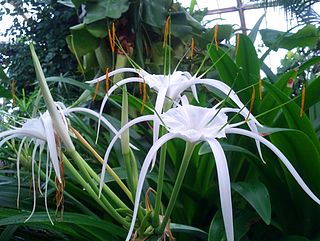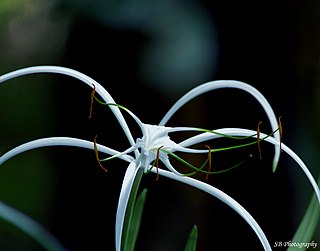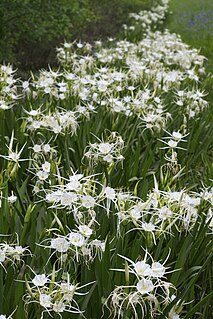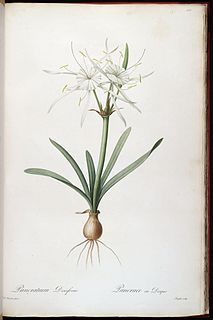
Typha latifolia is a perennial herbaceous plant in the genus Typha. It is found as a native plant species in North and South America, Europe, Eurasia, and Africa. In Canada, broadleaf cattail occurs in all provinces and also in the Yukon and Northwest Territories, and in the United States, it is native to all states except Hawaii. It is an introduced and invasive species, and is considered a noxious weed, in Australia and Hawaii. It has been reported in Indonesia, Malaysia, New Zealand, Papua New Guinea, and the Philippines.

Landsford Canal State Park is a South Carolina state park in Chester County, two miles (3.2 km) from US 21. The 448-acre (1.81 km2) park contains the ruins of the Landsford Canal built using slave labor to bypass rapids on the Catawba River between 1820 and 1825. The coming of the railroad caused the canal to be abandoned. The former lock keeper's house contains an interpretive museum. In addition to the canal, visitors also can see one of the largest remaining stands of Hymenocallis coronaria, the Shoals spider-lily, that grows in the shoals of the river and blooms from mid-May to mid-June. The park offers hiking, picnicking, boating, and fishing, as well as a playground.

Hymenocallis (US) or (UK) is a genus of American plants in the amaryllis family.

Spider lily is the common name for a number of different plant species within the family Amaryllidaceae which belong to the following genera:

Hymenocallis coronaria, commonly known as the Cahaba lily, shoal lily, or shoals spider-lily, is an aquatic, perennial flowering plant species of the genus Hymenocallis. It is endemic to the Southeastern United States, being found only in Alabama, Georgia, South Carolina and parts of North Carolina. Within Alabama, it is known as the Cahaba lily; elsewhere it is known as the Shoal lily or Shoals spider-lily.

Hymenocallis littoralis or the beach spider lily is a plant species of the genus Hymenocallis, native to warmer coastal regions of Latin America and widely cultivated and naturalized in many tropical countries.

Hymenocallis pimana is a member of the genus Hymenocallis, in the family Amaryllidaceae. Common name in English is Pima spider-lily; in Spanish it is cebollín. It is endemic to a small mountainous region in the Sierra Madre Occidental, straddling the Mexican states of Chihuahua and Sonora. Many of the people of the region are of the indigenous group known as the Mountain Pima or Pima Bajo.
Hymenocallis proterantha is a species of spider lily known only from Mexico.
Hymenocallis choctawensis is a plant in the family Amaryllidaceae, with the common names Choctaw spiderlily and Florida panhandle spider-lily. It grows along streambanks and in swamp forests of western Florida, eastern Louisiana, and southern parts of Alabama, Georgia and Mississippi.

Hymenocallis occidentalis is a plant species native to the southern United States. It is known along the Gulf Coast from South Carolina to Texas, and in the Mississippi Valley as far north as southern Illinois and Indiana. It is also cultivated as an ornamental elsewhere because of its showy, sweet-smelling flowers. Common names include woodland spider-lily, hammock spider-lily or northern spider-lily.

Hymenocallis palmeri is a plant in the family Amaryllidaceae. Common name is Alligator-lily. It is endemic to Florida, found in cypress swamps, wet meadows, open pine woodlands and wet roadsides.

Hymenocallis caribaea is a plant in the Amaryllidaceae with the common names "Caribbean spider-lily" or "variegated spider-lily." It is native to the islands of the Caribbean and to northern South America. It is regarded as native to Puerto Rico, Jamaica, Hispaniola, Cuba, the Virgin Islands, and the Windward and Leeward Islands, and the Venezuelan Antilles. It is also commonly cultivated as an ornamental in many other tropical and subtropical regions and reportedly naturalized in Sri Lanka, New South Wales, Bermuda, French Guinea, Suriname, and Guyana.
Hymenocallis guerreroensis T.M.Howard is a bulb-forming herb native to the Mexican states of Guerrero and Morelos. Common name "Guerrero spider-lily." It is sometimes cultivated for its showy white flowers.
Hymenocallis tridentata, the Florida spider-lily, is a bulb-forming herb native to southern Florida, to about as far north as Vero Beach. The species grows in marshes and wet prairies very close to sea level. It is similar to H. rotata, but somewhat smaller.

Hymenocallis liriosme is a North American bulb-forming herb native to Texas, Louisiana, Oklahoma, Arkansas, Mississippi and Alabama.
Hymenocallis puntagordensis the smallcup spiderlily or Punta Gorda spiderlily, is a plant in the Amaryllidaceae. It is a rare and little known endemic known only from the vicinity of Punta Gorda, in Charlotte County, Florida. This is on the Gulf coast just north of Fort Myers. The species is listed as "critically imperiled."
Hymenocallis henryae is a rare plant known only from 4 counties in northwestern Florida. Common names include "green spider-lily" and "Henry’s spider-lily."
Hymenocallis pygmaea Traub is a plant in the Amaryllidaceae found in the wild only in North Carolina and South Carolina. Common name is dwarf spider-lily, and it is cultivated as an ornamental in some regions.

Hymenocallis rotata is a plant in the family Amaryllidaceae, endemic to the north-central portions of the US state of Florida. It is found along the banks of spring-fed streams in the region.
Hymenocallis imperialis, common name Big Fatty, is a plant species native to the Mexican states of San Luis Potosí and Hidalgo. It is also cultivated in other regions as an ornamental.












